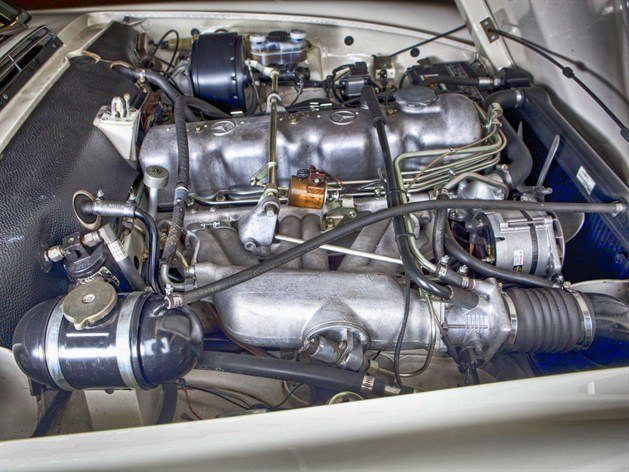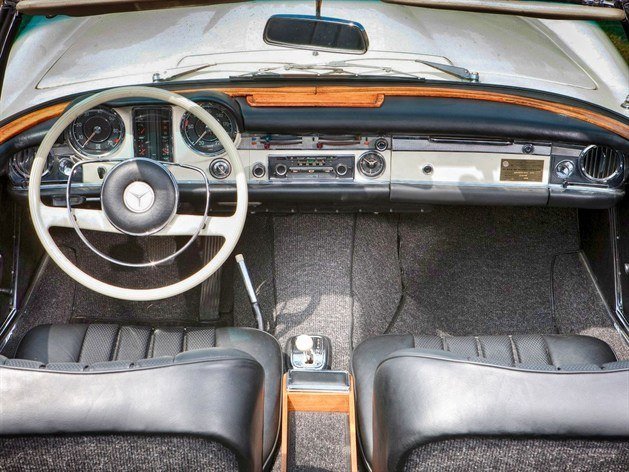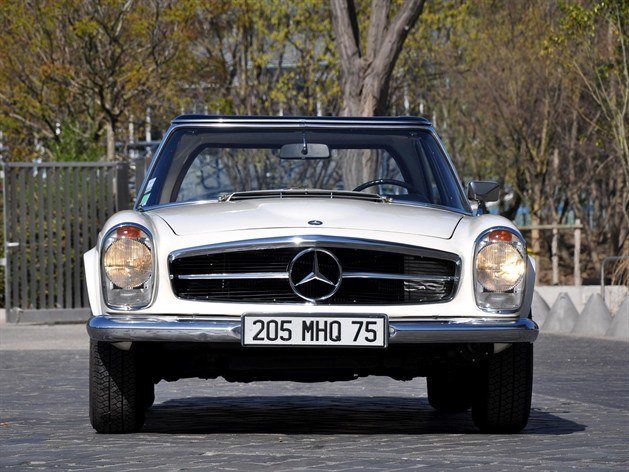Driving Mercedes-Benz SL Pagoda (1963 – 1971)
Perhaps the most iconic and best-loved of all 'affordable' Mercedes-Benz SLs, the W113 Pagoda has emerged from the long shadow cast by the 1954 Gullwing, and has a huge following in the classic car scene.
We put a Mercedes-Benz 280SL to the test to see if it lives up to the hype today.
Classic road test: Mercedes-Benz 280SL
Although the Pagoda first appeared in 1963, the story of the Mercedes-Benz Sport Leicht really begins with the 300SL Gullwing of 1954. The homologation special may have possessed styling to die for, but it was an uncompromising mistress that was horrendous to drive in the wet, appallingly overpriced and easily outrun by its Italian counterparts – but with a competition record to die, beguiling styling, and those doors, the flawed gem cemented the reputation of Mercedes-Benz as a truly top flight force in motor sport.
The tin-topped, gullwing gave way to the 300SL roadster in 1957 (which looked similar to the 1955 190SL) – and with it, the beginning of a line of ultra-expensive two-seater convertible Benzes. Although shorn of its look-at-me up-and-over doors and a fair degree of engineering purity, the roadster sold well – considering its list price was double that of a Jaguar XK140 – and laid the perfect foundation for its new-age successor, the W113 SL, or Pagoda to everyone who loves these cars.
About the Mercedes-Benz SL

Despite being similarly badged to the fire-breathing 300SL, the 1963 Pagoda was more closely aligned to the 190SL in terms of price. Based on the existing 220 floorpan, but with a shortened wheelbase, and packed with utterly conventional Benz engineering, the 230SL featured double wishbone suspension at the front and more driver-friendly swing axles at the rear. The sculptor and painter, Paul Bracq, lifted the Pagoda from mediocrity, though, by penning its iconic clothing.
Originally available in six-pot 2.3-litre form, the range expanded to include the 250 (1966-1968) and then the 280SL from 1968 – finally giving the tourer just enough go to match the show. Unlike the original 300SL, which was a preserve of the super-rich and famous, the Pagoda was far more accessible, and became a huge commercial success for its maker. During its eight-year production run, 48,902 were built – and thanks to a cult following and solid build quality, the survival rate remains thankfully high.
On the road

The Pagoda's styling is lovely, and that's what initially grabs your attention. There’s a purity of purpose and a delicacy of line that still stands up today. The wafer thin rear lamp clusters, the deftly sprinkled chrome, and lightly framed and undersized windscreen leave you in no doubt that vulgarity hasn’t always been the name of the game at Stuttgart.
Hook four fingers around the door handle, and pop the lock with your thumb, and it opens with a finely tuned click – even climbing in is a superior experience in the Pagoda. If you have the hood up or the hardtop in place, it’ll be about now that you’ll get your first good look at the interior, and once again, you’ll be impressed by just how tasteful an effort the dashboard and seats are. In comparison, the next generation R107 SL (or Lucy Ewing’s steed for all you Dallas fans) has all the charm and charisma of a leather trimmed attaché case.
Unlike many roadsters of its era, you don’t sit low in the Pagoda – and that means the view through the windcreen and down that gently humped bonnet is just about perfect. The pedals are nicely laid-out, and the minimalist ball-topped ball-selector is a mere palm rest away. Thin rimmed steering wheel is pleasant to caress – and its slightly oversized diameter promises a light and undemanding drive; shirt buttons are for the unwashed, you know.
Although the soothing engine and gearbox combination are well suited for cruising, the 280SL will play fast and loose in modern traffic conditions if need be
Finally, the body coloured dashboard somehow looks right, and the simply calibrated rev counter and speedometer flank the auxiliary gauges in the centre. It’s a command centre that means business. Consider it Teutonic, but with a warm and soothing twist.
Turn the dash-mounted ignition key, and the straight-six overhead cam engine upfront lumbers into life softly and settles down to a quiet, if slightly flat sounding idle. It’s smooth, though, and even before the off, you know it’s in keeping with the touring car pretensions your local Benz dealer has seduced you with.
The 280SL eases forward with all the grace and serenity of a small-bore limousine. It’s easy to understand just why so many Benzes are sold with automatic transmissions – its upchanges are pleasantly slurred, and throttle response is crisp and efficient. At no point are you left feeling frustrated by the transmission. Although the soothing engine and gearbox combination are well suited for cruising, the 280SL will play fast and loose in modern traffic conditions if need be. Floor the throttle, and the noses rises almost gracefully, and the acceleration takes on a more determined edge. With a 0-60mph time of 10 seconds, it’s never going to rip-up tarmac, but that’s more than enough pace for the typical owners of these cars.
With a ride quality best described as firm, you’d expect the SL to lack long distance comfort, but well-controlled damping and supportive seats would put a 500-mile day well within your reach if you felt that way inclined. Given that the natural stamping ground for this car and its well-heeled owner would be the French Riviera, it’s comforting to know that Cannes is a mere overnighter away.
It’s no wonder that the boot is so commodious, then. Many a saloon car would be embarrassed by the sheer amount that an SL will pack in. Golfers note – a bit of jiggling will see your bag installed without too much fuss…
In the UK, though, the touring car romance is harder to find – our pothole-riddled surfaces mean the SL is never fully settled. Corners, though, are more of a delight than you’d imagine – and although the light steering is well-geared and pleasantly weighted, it somehow lacks the feel that gives the driver the confidence to press on in style. However, on modern tyres, the limits are more than acceptable.
Spending time with the 250SL is a killer though – because its unassuming brand of magic will slowly reel you in. It’s incredibly easy to live with – hood up or down, it’s a cinch to see out of, and it goes well enough to see off you average modern family runabout. With your elbow resting on the door-top, fingertips caressing the wheel, and straight-six purring away, all seems right with the world – and one can imagine that piloting an SL in Harold Wilson’s England of 1968 would have a memorable experience in how to lord it up over the masses…
The HJClassics verdict

Could you live with a Mercedes-Benz 250SL today? It’s not really a question that needs much in the way of examination, because the answer’s obvious: of course you can. The way it goes, stops and steers mean that you’re not going to end up floundering at the first sign of a fast moving dual carriageway. Slaking its 20mpg thirst isn’t for the faint hearted though, so living with a Pagoda is not without its sacrifices. Entering into the debate as to whether any German car has true classic heart and soul is also irrelevant, because whether or not the Pagoda possesses that fine dose of recalcitrance that marks out a British or Italian thoroughbred, it’s a genuine feel-good car.
The reason that the normal rules of engagement don’t really hold true are because it’s a car that clearly has style and panache as well as tedious Teutonic reliability. Even more so than the mighty Gullwing that preceded it, the W113 generation of Mercedes-Benz SL is a car for all reasons. Also, everything about the way it looks is designed to stimulate those little pleasure receptors that leave you opening your chequebook regardless of the financial implications. It worked in 1968, and by goodness it works now.

Pictures: Bonhams

.jpg?width=640&height=426&rmode=crop)
.jpg?width=640&height=426&rmode=crop)
.jpg?width=640&height=426&rmode=crop)
.jpg?width=640&height=426&rmode=crop)
.jpg?width=640&height=426&rmode=crop)
.jpg?width=640&height=426&rmode=crop)
.jpg?width=640&height=426&rmode=crop)
.jpg?width=640&height=426&rmode=crop)

 Stylish, handsome and slightly unsporting default choice roadster
Stylish, handsome and slightly unsporting default choice roadster
 Full restorations are not for the faint hearted, financially
Full restorations are not for the faint hearted, financially




